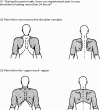Prevalence of shoulder pain in the community: the influence of case definition
- PMID: 9175931
- PMCID: PMC1752371
- DOI: 10.1136/ard.56.5.308
Prevalence of shoulder pain in the community: the influence of case definition
Abstract
Objective: To compare estimates of the occurrence of shoulder pain according to (a) different approaches to defining 'shoulder' and (b) restricting the definition to only include those with associated disability.
Methods: A postal questionnaire survey was sent to a sample of 500 patients registered with a general practice in south Manchester. After additional mailings to non-responders, 312 questionnaires were returned (66% adjusted response rate). Four definitions of shoulder pain were used to estimate the occurrence of symptoms derived from answers to the questionnaire. Two were based on questions asking directly about pain in the shoulder and the upper trunk and neck region respectively and two were based on markings on a pain drawing in the shoulder complex and the upper trunk respectively. To determine the occurrence of disabling shoulder pain responders were subsequently approached for interview. Of the responders, 232 (74%) were successfully interviewed. Those indicating that they were suffering from 'current' shoulder symptoms, pain on the day of interview, were asked to complete a short, 23 item, questionnaire enquiring about disability in daily living associated with such symptoms.
Results: In total 160 (51%) people reported shoulder pain according to at least one definition. This one month period prevalence ranged from 31% to 48% across the four definitions with the lowest estimate being for the question asking directly about shoulder symptoms. In total 84 people (27% of all respondents) answered positively to all four definitions. Only seven people who answered positively when asked directly about shoulder pain did not indicate symptoms on the pain drawing in the shoulder complex. By contrast 65 (30%) of those answering negatively to the direct question about shoulder pain indicated symptoms on the pain drawing in the upper trunk region or answered positively to the direct question about pain in the upper trunk or neck region. However only 19 (9%) of those answering negatively to the direct question indicated symptoms in the shoulder complex on the pain drawing, compared with 38 (18%) indicating symptoms in the upper trunk region and 59 (27%) symptoms in the upper trunk and neck region. Limiting the definition to only include current symptoms with some associated disability (at least one item on the disability questionnaire being answered positively) restricted the point prevalence to 20% (n = 46).
Conclusions: Using a pain drawing based definition with case ascertainment restricted to an area in and around the shoulder complex is recommended for surveys assessing the occurrence of shoulder symptoms in the general population. To solve the problem of the poor specificity associated with symptom based definitions it is useful to incorporate an additional classification to restrict the definition to more disabling problems.




